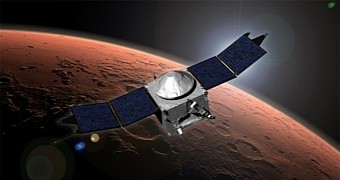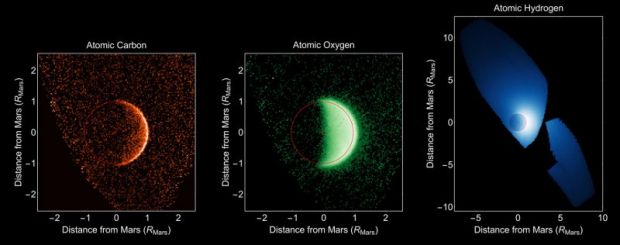As it turns out, the Red Planet is under the impression that it's a competitor on a cosmic edition of “The Biggest Loser.” In a nutshell, it's shedding hydrogen like crazy and seems anything but willing to ditch its version of fitness routine anytime soon.
Besides, scientists with NASA (the US National Aeronautics and Space Administration) say that, according to evidence provided by the MAVEN spacecraft, which is now orbiting the planet, Mars is also shaking off oxygen and carbon.
Documenting changes in Mars' atmosphere
NASA's MAVEN spacecraft left our planet on November 18, 2013, and took several months to reach Mars. Thus, MAVEN officially began orbiting the Red Planet this past September 21.
The spacecraft has one very important mission: use the scientific instruments that it is fitted with to study the makeup and the evolution of the Red Planet's atmosphere in unprecedented detail, and report back to scientists at NASA.
Having spent some time orbiting the planet, MAVEN appears to have already gained a better understanding of what is now happening to Mars' atmosphere. The spacecraft's findings were made public by NASA this past October 14.
Long story short, scientists say that the Red Planet is presently losing quite a lot of the hydrogen it packs in its atmosphere. As detailed in the image below, the hydrogen is moving away from the Red Planet in clumps and streams.
These clumps and streams are working their way into space, and many have until now covered distances comparable to 10 times Mars' radius. The hydrogen atoms are understood to originate from water vapors that are breaking apart in the planet's atmosphere.
“That's effectively removing water from the Martian atmosphere,” MAVEN scientist and University of Colorado researcher Mike Chaffin commented on these findings in a recent interview with the press, as cited by Nature.
According to NASA, the Red Planet is not losing just hydrogen. On the contrary, oxygen and carbon appear to be leaving Mars' atmosphere as well. The path taken by these other atoms is also documented in the image below.
The carbon and the oxygen have not yet moved as far away from Mars as the hydrogen did due to the fact that these atoms are slightly heavier. Hence, they are having trouble breaking free from their home planet's pull.
What's interesting is that, of the oxygen circling the Red Planet, the atoms found deep within the atmosphere are clumping together to form ozone. The ozone birthed by these atoms is said to be building up close to Mars' south pole.
MAVEN's mission is far from over
The MAVEN spacecraft might have successfully documented what the hydrogen, oxygen and carbon atoms circling this planet are up to, but the fact of the matter is that it still has plenty of work left to do.
Thus, the spacecraft is expected to soon peer even deeper into the makeup of the Red Planet's atmosphere, and try to figure out how solar winds have transformed it over the millennia, causing it to thin to a considerable extent.
Come October 19, however, the spacecraft will take a break from its usual schedule. This is because, on this date, the Red Planet will be visited by a comet dubbed Siding Spring.
MAVEN is expected to snap a few photos of this comet, and study the impact of Siding Spring's huge trail of dust on the planet's atmosphere.

 14 DAY TRIAL //
14 DAY TRIAL // 

